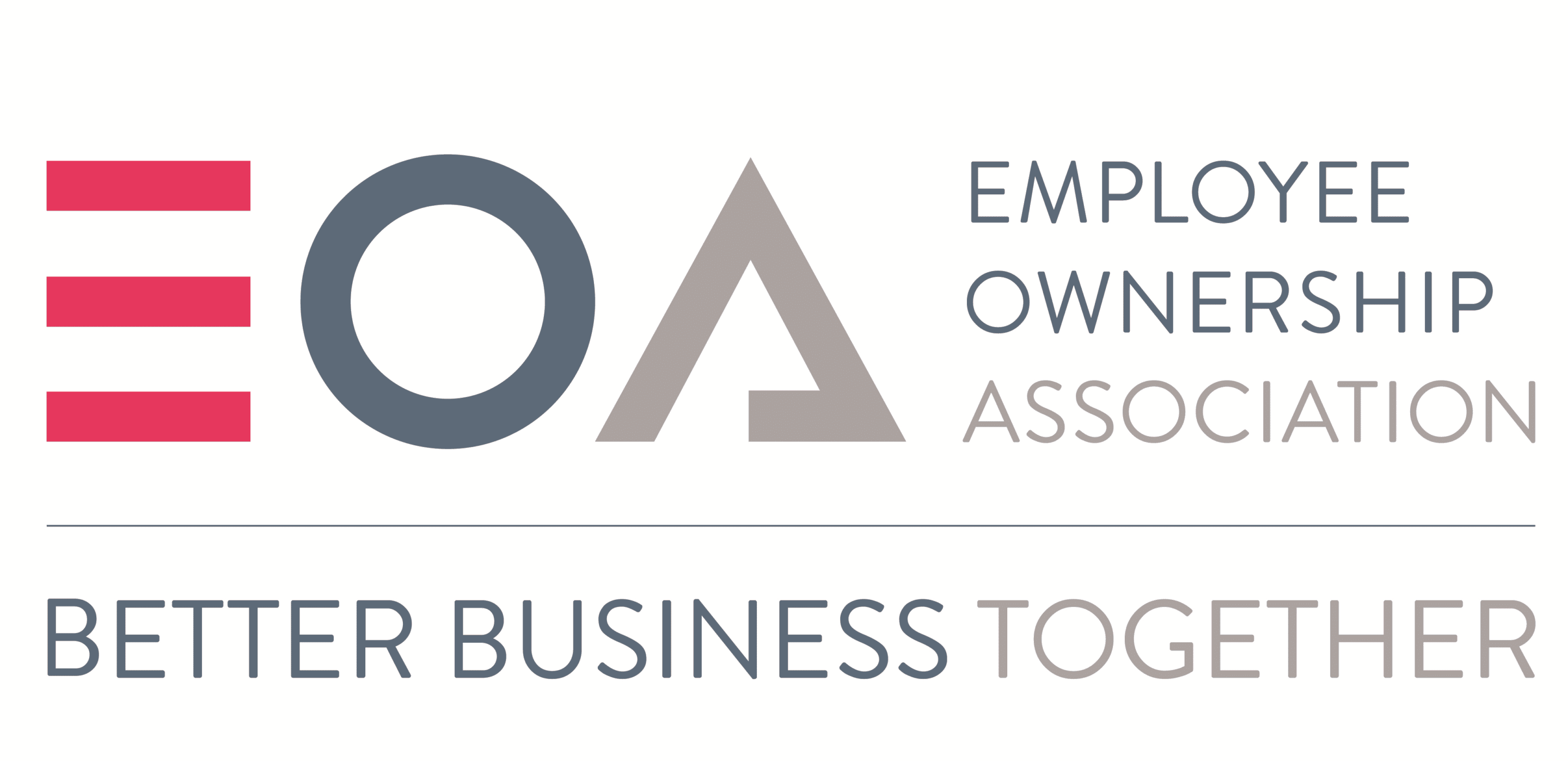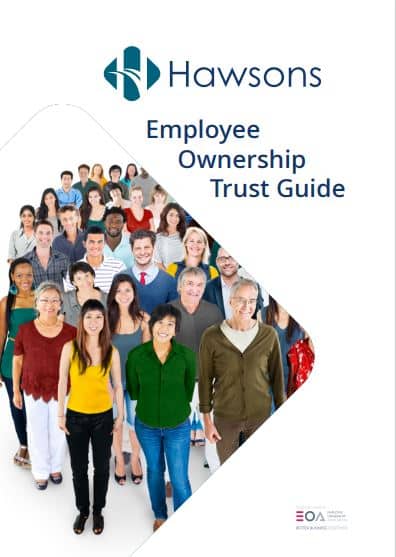Employee Ownership Trust Advisers (EOT)
An exit strategy with attractive tax benefits and peace of mind over the future of your business. Our experts operate on a nationwide basis.
Looking for an exit strategy that ensures your business’s future?
Selling to an Employee Ownership Trust allows a company to be owned by a trust for the benefit of the employees. An employee-owned business typically achieves higher productivity, greater levels of innovation and are more resilient to economic turbulence. In addition, an EOT is beneficial for shareholders looking for a tax-efficient exit strategy.
Hawsons Corporate Finance is a dedicated team of experienced corporate finance specialists who provide lead advisory, business valuations, finance raising, and taxation services to clients establishing ownership structures using an EOT.
We are members of the EOA

Does an EOT suit my company?
Although not the perfect fit for every company. Employee ownership provides a tailored approach to many companies based on its inherent flexibility. As an exit strategy, employee ownership provides a sustainable pathway whilst also establishing a positive legacy.
When compared with other exit strategies, employee ownership can be characterised as a cooperative model which avoids high-level disruption. The employee ownership route can preserve company culture and avoid a potentially hostile restructure from a third party.
Employee ownership is a method that retains control over the company’s succession and is centered around employee reward, leadership and innovation.
What are the benefits of transitioning to an EOT?
Benefits of transitioning to an EOT
Benefits to the sellers:
Sellers can exit with assurances that their employees will be looked after
Sellers have more control over the sale process and timings
No due diligence
Reduced buyer risk
CGT exemption when sold to an EOT
Benefits to the employees:
Tax-free bonus
Increased control
Shareholder benefits
Employee engagement
What are the qualifying criteria?
To benefit from the relief a company must comply with the following criteria:
- The company must be trading.
- The trustees must have a controlling interest in the company, meaning that the majority of shares and voting rights must be held by the trustees on behalf of the employee beneficiaries.
- The controlling interest must apply to share capital as well as voting rights and assets.
- Trust assets should be available on (broadly) the same terms for eligible employees although some exceptions will apply.
- Different considerations must be applied to the trust assets, for example, length of service.
- Restricting assets for the benefit of some employees should be avoided.
The qualifying criteria should be satisfied before a company may claim or benefit from the relevant tax reliefs. The legislation provides additional measures that are to be met in order for a company to qualify.
Our Process

Valuation
Our experienced corporate finance team can prepare a valuation report for the company, offering reassurance to both parties being the exiting shareholders and the remaining employees that the business is being transferred over to the trust at a fair market price.
Sourcing Finance
It is likely that the trust will not have the funds to complete the deal without external finance. We can assist by introducing the exiting shareholders to lenders, and offering support and advice throughout the process. In particular, we can prepare financial forecasts in order to satisfy lender requirements.
EOT Design & Tax Structuring
We can assist in the deal structure and the design of the EOT alongside the solicitors, ensuring that there is full transparency from the outset with regards to consideration received by the exiting shareholders, and the timing of payments.
Oversight & Communication
We will offer support and guidance throughout the entire process and will assist in communicating plans to current employees at the appropriate time(s).
Client success stories
Essential Recruitment
- Essential Recruitment specialises in the supply of temporary and permanent staff
- Founded in 2006 and has six branches.
- Directors choose an EOT because they wanted to reward staff loyalty.
PA Jewellery
- Local family-run Jewellery company founded in 1976.
- PA Jewellery wanted to find a succession plan to protect employees’ future.
- Transitioned into an EOT in 2018.
Specialised Movers
- Specialised Movers Limited is a storage and removals company.
- The owners were keen to find a suitable succession strategy, that provided a secure future for its employees
- A transition to an EOT was the perfect fit.
What do our clients think?
Our EOT expertise
This year, we have advised many businesses to complete their transition to employee ownership. Hawsons have been working with businesses on EOTs since they were introduced in 2014, completing our first deal in 2016.
There are now 1,500 businesses across the UK that are employee-owned. We are a member of the Employee Ownership Association who represent organisations that are employee-owned or transitioning to employee ownership across the UK.
Our case studies and reviews demonstrate that our clients are very happy with the service we have provided.
Signup for EOT updates
Videos
Transitioning to an EOT – A company perspective
What are the key benefits of an EOT transaction?
Sourcing finance for an EOT transaction
What is the full process of transitioning to an EOT?
What is the legal process of transitioning to an EOT?
How is an EOT deal structured?
Frequently Asked Questions
What is an EOT?
An EOT is a form of indirect employee ownership and is usually achieved by the sale of a controlling interest in a trading company to a trust. The trust then holds the controlling interest in the company for the long-term benefit of the employees as a whole.
The EOT becomes the owner of the company and is administered by trustees on behalf of the employees, the trustees could consist of the exiting owners of the company, an independent chairperson, and employee representatives.
How do EOT's work?
An EOT is a form of indirect employee ownership and is usually achieved by the sale of a controlling interest in a trading company to a trust. The trust then holds the controlling interest in the company for the long-term benefit of the employees as a whole.
The EOT becomes the owner of the company and is administered by trustees on behalf of the employees, the trustees could consist of the exiting owners of the company, an independent chairperson, and employee representatives.
Is an EOT right for me?
This is a difficult question because so many different factors come into play but it is fair to say it is not right for every business or situation. That said, in the right situation, an EOT is a fantastic opportunity for an existing shareholder to benefit from a tax-free disposal of shares.
What are the benefits of an employee ownership?
Short term
- Exempt from Capital Gains Tax on disposal of shares to an EOT;
- Current owners can still hold up to 49% of the business;
- Incentivises management and key employees;
- An attractive alternative to a free market trade for those looking to sell quick and efficiently, and at market value.
Long term
- Closer alignment of the interests of employees and stakeholders;
- Improves business performance as employees have more of an incentive to succeed;
- Improves employee retention;
- Improves employee engagement and innovation;
- Tax-free bonuses for employees (up to £3,600 per year for each employee).
Why use an accountant as your lead EOT advisor?
The starting point in any EOT transaction is to have an open and full open discussion about the suitability of an EOT as a succession solution for you and your business. Once suitability is established, the journey to employee ownership can commence.
Not only should you expect your accountant to discuss the whole process in detail with you, during an EOT transaction your chosen accountant is likely to be responsible for many key elements of the EOT process, including:
- The independent valuation of your business
- Sourcing finance for the sale of your business to an EOT
- Helping ensure the proposed EOT is tax compliant
- Guiding how the company will be governed under employee ownership
How does an Employee Ownership Trust work?
An EOT is very similar to an employee benefit trust. But with two key differences. Firstly, an EOT has to have a controlling stake in the company. Secondly, an EOT must benefit all employees equally.
How to fund an Employee Ownership Trust?
In the first instance, an EOT sale is funded through the company's surplus cash. However, any remaining cash needed for the EOT to purchase the company will be repaid to the existing shareholders over time using the future profits that the company makes.
Are Employee Ownership Trusts supported by the government?
The UK Government is actively considering converting employee ownership trust shares into business exit plans in the future. To achieve this the Government offers substantial tax benefits to owners who sell their homes, along with annual tax benefits. Various government agencies favor employee ownership models.
Tell me about the John Lewis model?
John Lewis's business models emphasize employee ownership where the employee owns the entire company. It gives them a stake in its annual revenues and has an active role in how it's run. Generally speaking this business model aims to improve company performances due in part to employee participation which provides a further incentive to the successful business.
What is the difference between an EOT and an EBT?
An EBT is a discretionary trust established by the employer.
An EOT is a trust that acquires shares in a company and holds them on behalf of the employees. It is an increasingly popular exit strategy for shareholders which offers attractive tax incentives and peace of mind over the future of the business and its employees.
Find out more about the differences between an EOT and an EOT.
What is the eligibility criteria for EOT?
The qualifying criteria is in place to ensure that the employees, as beneficiaries, receive these benefits and that exiting shareholders are not abusing the generous tax reliefs on offer as part of this exit strategy.
What are the tax free bonuses?
Providing certain key conditions are met, each employee will be exempt from income tax on the first £3,600 of bonuses per year.
What are the benefits of an EOT for the employees?
Employees benefit from:
- Tax-free bonuses
- Increased control
- Shareholder benefits
What is the role of a trustee in an EOT?
The trustees are the directors of the corporate trustee company which holds the shares in the trading company/group. Their role is to ensure that the company is being managed (by the directors of the trading company) in the best interests of the employees as a whole.
What is the accounting treatment of an EOT?
The EOT becomes the owner of the company, usually via a corporate trustee company (“the Trust”) set up to hold the acquired shares. The trust is administered by trustees on behalf of the employees, these trustees are statutory directors of the corporate trustee company.
How are profits distributed following EOT ownership?
EOT’s are a form of indirect company ownership and as such dividends would not get paid directly to employees should they become payable.
When profits and cashflow allow, a contribution can be made to the trust which is then available to be shared amongst the employees.
What are the disadvantages of an EOT?
Whilst there are many advantages to an EOT transaction (which are highlighted in our other articles), there can be disadvantages.
It is common in more traditional business sales for the exiting shareholders to receive the majority of their proceeds on completion of the sale, with an EOT transaction this is typically not the case and sellers can have to what many years to be paid in full.
Our Employee Ownership Trust experts
Pete Wilmer
Corporate Finance Partner
Pete leads the Corporate Finance offering across the firm, having has spent much of his career within a large international accountancy firm and corporate banking before returning to Hawsons, where he started. Working with businesses of all sizes, Pete has an exceptional breadth of experience which he brings to the benefit of clients.
An early adopter and passionate believer in good employee ownership, Pete has helped numerous businesses transition to employee ownership and works extensively to promote the employee ownership model.





